Social Progress Index Analysis Project in PythonAn indicator of social advancement around the world is the Social Progress Index (SPI). It aids in comprehending how much concern other nations have for the general welfare of their population. This tutorial is for you if you want to examine the social progress index. This post will walk you through a Python-based Social Progress Index analysis. Three dimensions are combined in the index:
This framework encompasses various interconnected elements that the academic research and practitioner experience have identified as supporting social advancement. Four components per dimension, each comprising three to five distinct outcome indicators. The indicators chosen for inclusion are accurately measured across all (or nearly all) of the sample countries by the same organization using a standardized technique. The Social Progress Index's two main characteristics are:
When creating the Social Progress Index, Social Progress Imperative considered hundreds of potential indicators, consulting with MIT experts to identify the metrics that best distinguished between countries' performances. The index employs outcome measures when there are enough data or the most accurate proxies. Social Progress Index AnalysisThe total level of development of a nation's inhabitants is considered while calculating the Social Progress Index score. The following are all the variables taken into account while determining the Social Progress Score:
Thus, these are the main variables when determining a country's SPI score. On Kaggle, I discovered a dataset with all these elements. Analyzing the Social Progress Index will be useful. You can go website Kaagle.com and download the dataset Before continuing, I want to ensure you know that Tableau is the best option if you want to construct an advanced data science project on the Social Progress Index Analysis because such datasets can be better visualized and studied on dashboards. In the section below, you can learn how to use Python to analyze the social progress index. About DatasetThe Social Progress Index (SPI) gauges how well nations meet the requirements of their population in the social and environmental spheres. The relative performance of countries is shown through 55 indicators in the categories of fundamental human needs, pillars of well-being, and chance for advancement. Instead of focusing on economic variables, the SPI directly observes social and environmental consequences to determine a society's level of well-being. Wellness (including health, housing, and sanitation), inclusion, sustainability, equality, and personal freedom and safety, are among the social and ecological elements. COLUMN DESCRIPTION
FILE NAME:spi.csv Social Progress Index Analysis using PythonLet's begin by importing the dataset and the relevant Python libraries: Output: spi__rank country spi__score basic__human__needs wellbeing \ 0 1.0 Norway 92.63 95.29 93.30 1 2.0 Finland 92.26 95.62 93.09 2 3.0 Denmark 92.15 95.30 92.74 3 4.0 Iceland 91.78 96.66 93.65 4 5.0 Switzerland 91.78 95.25 93.80 opportunity basic_nutri_med_care_ water_sanitation_ shelter \ 0 89.30 98.81 98.33 93.75 1 88.07 98.99 99.26 96.48 2 88.41 98.62 98.21 94.92 3 85.04 98.99 98.82 93.16 4 86.28 98.72 98.96 92.97 personal_safety_ access_basic_knowledge_ access_info_comm_ health_wellness_ \ 0 90.29 98.66 95.80 89.32 1 87.75 96.32 95.14 85.73 2 89.46 97.44 98.18 85.15 3 95.66 99.51 93.12 91.02 4 90.35 98.60 95.07 91.50 env_quality_ personal_rights_ personal_freedom_choice_ inclusiveness \ 0 89.44 96.34 91.16 83.77 1 95.15 96.13 88.10 82.81 2 90.20 97.08 90.03 81.64 3 90.93 95.14 88.01 77.63 4 90.05 96.69 90.65 74.81 access_adv_edu_ 0 85.92 1 85.23 2 84.89 3 79.39 4 82.99 Al the important factors like Essential human needs, Wellbeing, Opportunities, Food and fundamental medical care, Water and hygiene, Protection, Personal Security, Access to knowledge that is fundamental, Access to information and communication, Fitness and health, Environmental protection, Individual rights, Individual discretion and decision, Diversity, Access to higher education, etc, are coved in the columns of this dataset. Query: Output:
spi__rank country spi__score basic__human__needs \
164 165.0 Eritrea 35.33 44.94
165 166.0 Chad 34.60 35.65
166 167.0 Central African Republic 33.53 29.91
167 168.0 South Sudan 32.50 39.96
168 NaN World 65.05 74.18
wellbeing opportunity basic_nutri_med_care_ water_sanitation_ shelter \
164 35.95 25.10 57.92 27.91 50.27
165 36.26 31.87 47.24 21.48 33.00
166 34.83 35.84 36.42 26.95 26.79
167 34.17 23.37 59.29 24.43 33.28
168 64.42 56.54 84.92 69.99 80.63
personal_safety_ access_basic_knowledge_ access_info_comm_ \
164 43.67 40.18 6.81
165 40.90 23.14 24.31
166 29.46 34.81 22.57
167 42.84 27.18 9.16
168 61.20 72.03 70.22
health_wellness_ env_quality_ personal_rights_ personal_freedom_choice_ \
164 41.68 55.12 14.88 37.86
165 41.47 56.13 52.04 28.66
166 24.60 57.35 52.39 26.67
167 37.14 63.22 27.40 32.50
168 60.18 55.27 60.16 62.22
inclusiveness access_adv_edu_
164 24.82 22.84
165 22.03 24.76
166 37.87 26.43
167 13.42 20.17
168 42.22 61.58
Showing Basics StatisticsIt's time to gain an overview of the values that each column in your dataset includes now that you've seen what data types are present. This is possible with. describe(). The describe() method of the Pandas DataFrame is used to compute some statistical data, such as percentile, mean, and standard deviation of various quantitative data of the DataFrame. It is used to examine numeric data, object series, and DataFrames with mixed-type column sets. The describe() method of a Pandas DataFrame provides all the necessary details about the data, which can then be used to analyze the data and generate further mathematical hypotheses for research. The Pandas library's statistics section is handled by the DataFrame describe() function. By default, the describe() method only examines numeric columns, but if you use the include parameter, you can supply other data types. Output:
spi__rank spi__score basic__human__needs wellbeing opportunity \
count 168.000000 169.000000 169.000000 169.000000 169.000000
mean 84.500000 67.433136 76.142959 67.774379 58.381657
std 48.641546 15.012150 16.252248 15.397385 15.805868
min 1.000000 32.500000 29.910000 34.170000 23.370000
25% 42.750000 55.170000 62.650000 55.480000 47.900000
50% 84.500000 68.090000 82.460000 67.350000 56.440000
75% 126.250000 78.810000 88.700000 79.200000 69.480000
max 168.000000 92.630000 96.850000 93.800000 89.300000
basic_nutri_med_care_ water_sanitation_ shelter personal_safety_ \
count 169.000000 169.000000 169.000000 169.000000
mean 84.705976 76.122840 77.088166 66.656509
std 14.414040 23.408526 18.811647 14.404784
min 36.420000 14.800000 26.790000 29.460000
25% 72.420000 57.060000 64.570000 55.810000
50% 91.330000 86.150000 87.300000 67.210000
75% 96.720000 96.750000 90.620000 76.340000
max 98.990000 99.270000 96.870000 96.180000
access_basic_knowledge_ access_info_comm_ health_wellness_ env_quality_ \
count 169.000000 169.000000 169.000000 169.000000
mean 74.758698 66.822367 62.325562 67.189704
std 19.464110 20.382707 16.034389 14.340080
min 23.140000 6.810000 21.030000 23.950000
25% 61.560000 52.110000 49.530000 58.290000
50% 79.080000 70.280000 62.370000 67.280000
75% 91.220000 82.750000 73.330000 77.540000
max 99.510000 98.180000 92.100000 95.150000
personal_rights_ personal_freedom_choice_ inclusiveness access_adv_edu_
count 169.000000 169.000000 169.000000 169.000000
mean 69.627811 62.908343 46.802840 54.188166
std 21.535655 15.078164 17.008499 18.564111
min 14.880000 26.670000 4.260000 19.700000
25% 54.010000 52.670000 34.300000 36.230000
50% 71.200000 62.420000 47.240000 54.320000
75% 88.660000 73.790000 58.150000 68.470000
max 97.910000 91.160000 83.770000 89.600000
According to the SPI ranking, Norway leads the world in the Social Process Index. Before continuing, let's have a look at the column insights: Output: 1 So that we can classify scores as high and low, let's now examine the highest, average, and lowest SPI scores: Output: Highest Score of SPI : 92.63 Lowest Score of SPI : 32.5 Average Score of SPI: 67.43313609467457 We can define 85 as the minimum need for a high SPI score because 92 is the highest, and 67 is the average SPI score. Let's examine some information regarding the nations with high SPI scores. Let's start by examining the nations that have superior access to facilities for fundamental human needs: Output: 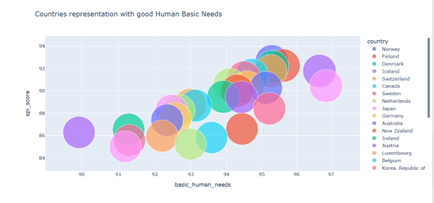
The two nations with the best infrastructure for meeting fundamental human requirements are Iceland and the Japanese. Let's now examine the nations that offer more opportunities: Output: 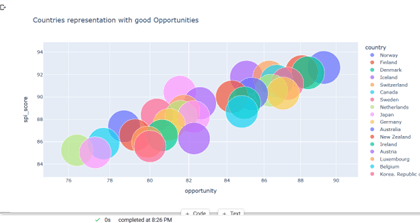
There are more opportunities in the top 3 nations: Denmark, Norway, and Finland. Let's now examine the nations with the best food and medical facilities: Output: 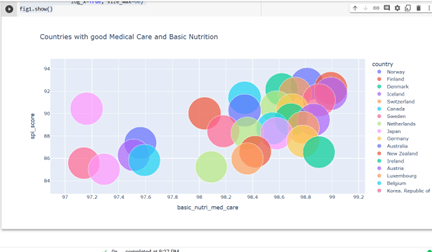
The top 3 nations with the best access to healthcare and nutrition are Iceland, Finland, and Norway. Let's now examine the nations with greater water sanitation: Output: 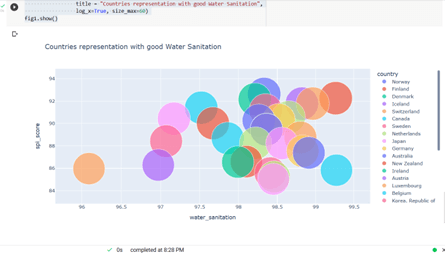
The two nations with the best water sanitation practices are Switzerland and Finland. So, using this method, we can examine every element used to determine the SPI score. Let's now make a choropleth map representation to examine the worldwide Social Progress Index scores as a whole: Here we are setting dictionary values with locations, location mode, and text to be displayed on the console. Also, we are setting the projection type to 'azimuthal equal area'. At last, we will plot the figure using the iplot() function. Consolidated Code:Output: 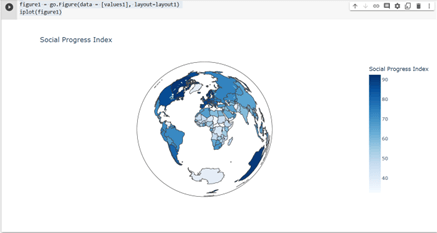
Thus, this is how the Python computer language can be used to examine the Social Progress Index. SummaryI hope you enjoyed reading this post about Python's Social Progress Index Analysis. An indicator of social advancement around the world is the Social Progress Index (SPI). It aids in comprehending how much concern other nations have for the general welfare of their population.
Next TopicAdvance Bar Graph in Python
|
 For Videos Join Our Youtube Channel: Join Now
For Videos Join Our Youtube Channel: Join Now
Feedback
- Send your Feedback to [email protected]
Help Others, Please Share










